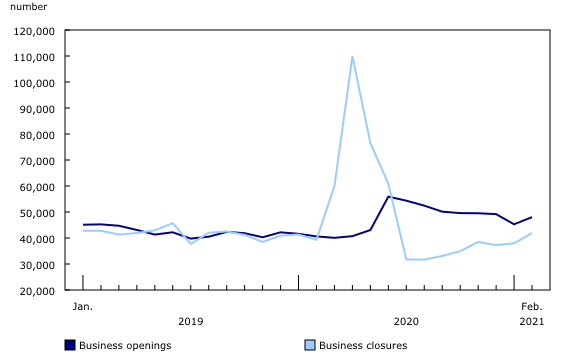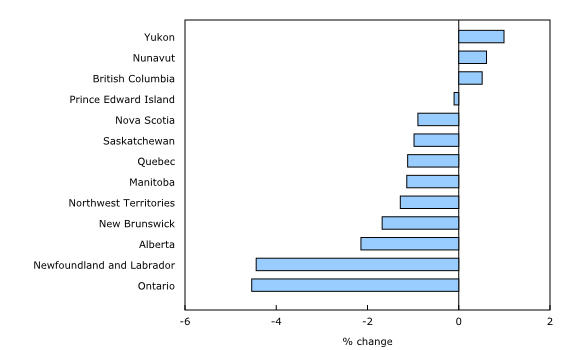Monthly estimates of business openings and closures, February 2021
Archived Content
Information identified as archived is provided for reference, research or recordkeeping purposes. It is not subject to the Government of Canada Web Standards and has not been altered or updated since it was archived. Please "contact us" to request a format other than those available.
Released: 2021-05-28
In February, as public health restrictions were eased in many provinces, the number of business openings increased 6.1%, of which the majority (62.4%) was due to the number of reopening businesses, unchanged from last month. The number of business closures also rose compared with January, up 10.4%. Indeed, the number of business closures has been trending up since August 2020, but returning to historical levels. However, as the number of business closures continued to be lower than that of business openings, the number of active businesses in February edged up. Despite this slight increase, the number of active businesses in February was down 1.9% compared with February 2020.
Business closures rose in every province and territory from January to February, except Yukon, where closures were relatively unchanged. Ontario recorded the largest increase in business closures, up 19.0% (+2,858) from January. While public health restrictions were eased in some regions of Ontario in early February, a stay-at-home order remained in place throughout the month in other regions, such as Toronto and Peel. In contrast, in Quebec, despite an extended curfew, business closures edged up 1.2% (+83)—the smallest percentage increase among the provinces.
The number of active businesses continues to lag behind pre-pandemic levels in most provinces
Across most of the country, while the number of active businesses continued on an upward trend, it remained below the pre-pandemic levels recorded in February 2020, or one year prior to the most recent month for which data are available. In particular, the number of active businesses in Ontario (-4.5%) and Newfoundland and Labrador (-4.4%) remained lower compared with one year earlier. In contrast, in Yukon, Nunavut and British Columbia, the number of active businesses in February 2021 surpassed pre-pandemic levels, with increases up to 1%. As public health restrictions were re-introduced in British Columbia in late March, it remains to be seen whether the trend in active businesses will continue.
If the number of active businesses in Canada continues to grow at a pace similar to that of the last few months (average growth of 1.0% per month), it is expected to return to its pre-pandemic level by May 2021.
Business closures trending up in industries most affected by public health restrictions, but returning to historical levels
Similar to provincial results, increases in the number of business closures were relatively widespread across industries, except other services (except public administration) (-2.6%; -446) and manufacturing (-2.5%; -30), where closures decreased. In the industries most affected by the pandemic, namely accommodation and food services, arts entertainment and recreation, and retail trade, the number of business closures has been trending up since August 2020 and were more than 10% higher than the level observed in February 2020. Nevertheless, as business openings exceeded closures in these industries, the number of active businesses continued to grow, albeit at a slow pace.
The increase in business openings from January to February 2021 was largely driven by the rise in business openings in other services (excluding public administration) (+64.6%; +1,727) and accommodation and food services (+7.8%; +267). The shares of business reopenings in these two industries (77.2% and 79.6%, respectively) were above the business sector average of 62.7% and about 10 percentage points higher than one year earlier. This may be attributable to the easing of public health restrictions in many provinces, which allowed businesses in these industries to re-open.
Note to readers
Every new month of data leads to a revision of the previously released data because of such factors as the seasonal adjustment process and the publication of a new version of the Generic Survey Universe File (or vintage of the Business Register). As a result, estimates may vary when compared with a previous data release.
Openings are defined as businesses with employment in the current month and no employment in the previous month, while closures are defined as businesses with employment in the previous month, but no employment in the current month. Continuing businesses are those with employees in both months, and the active population in any given month is the number of opening and continuing businesses in that month. Reopening businesses are defined as opening businesses that were also active in a previous month (i.e., they closed in a given month and had positive employment in a subsequent month). In contrast, entrants are opening businesses that were not active in a previous month.
A business is defined as an enterprise operating in a particular geography and industry.
The vast majority of businesses operate in one industry and one location or geography. These businesses will be counted once at the national and provincial level in the monthly estimates of openings and closures. For example, a retailer in Windsor, Ontario, will be counted as an active business in the Ontario estimates and once in the national estimates.
Some businesses can have multiple operations, and these can be in different industries and geographies. Such businesses can be counted more than once in the monthly estimates of openings and closures because they are active in multiple industries or geographies. For example, if a retailer has operations in both Alberta and Ontario, it will be counted as an active business in both provinces, but only once at the national level because it represents only one active firm. Similarly, a firm with retail and wholesale operations will be counted in both industries when individual industries are examined. However, when the business sector is examined, the firm counts only once because at that level it represents one firm active in the business sector.
Contact information
For more information, contact us (toll-free 1-800-263-1136; 514-283-8300; STATCAN.infostats-infostats.STATCAN@canada.ca).
To enquire about the concepts, methods or data quality of this release, contact Amélie Lafrance (343-572-3221; amelie.lafrance@canada.ca), Economic Analysis Division.
- Date modified:



